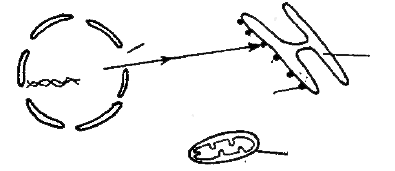What voltage must be applied to an elect-non microscope to produce electrons of wavelength 0.4A?
To find the voltage that must be applied to an electron microscope to produce electrons of wavelength 0.4Å, we can use the de Broglie wavelength formula. Here’s a step-by-step solution:
Step 1: Write down the de Broglie wavelength formula
The de Broglie wavelength λ of a particle is given by the formula:
λ=h√2meV
where:
- h is Planck's constant (6.626×10−34Js),
- m is the mass of the electron (9.11×10−31kg),
- e is the charge of the electron (1.6×10−19C),
- V is the potential difference (voltage) we need to find.
Step 2: Rearrange the formula to solve for V
We can rearrange the formula to isolate V:
√V=hλ√2me
Squaring both sides gives:
V=(hλ√2me)2
Step 3: Substitute the known values
Now, substitute the known values into the equation:
- Convert 0.4Å to meters:
0.4Å=0.4×10−10m=4×10−11m
- Now substitute h, λ, m, and e:
V=⎛⎜
⎜⎝6.626×10−34(4×10−11)√2×(9.11×10−31)×(1.6×10−19)⎞⎟
⎟⎠2
Step 4: Calculate the denominator
First, calculate 2me:
2me=2×(9.11×10−31)×(1.6×10−19)=2.917×10−49kg C
Now calculate √2me:
√2me=√2.917×10−49≈5.4×10−25kg1/2C1/2
Step 5: Substitute back into the voltage equation
Now substitute this back into the equation for V:
V=(6.626×10−34(4×10−11)×(5.4×10−25))2
Step 6: Calculate V
Calculating the numerator:
6.626×10−34(4×10−11)×(5.4×10−25)≈30.675
Now square this value:
V≈(30.675)2≈940.96V
Final Answer
The voltage that must be applied to the electron microscope is approximately:
V≈940.96V
The de Broglie wavelength λ of a particle is given by the formula:
λ=h√2meV
where:
- h is Planck's constant (6.626×10−34Js),
- m is the mass of the electron (9.11×10−31kg),
- e is the charge of the electron (1.6×10−19C),
- V is the potential difference (voltage) we need to find.
We can rearrange the formula to isolate V:
√V=hλ√2me
Squaring both sides gives:
V=(hλ√2me)2
Now, substitute the known values into the equation:
- Convert 0.4Å to meters:
0.4Å=0.4×10−10m=4×10−11m
- Now substitute h, λ, m, and e:
V=⎛⎜
⎜⎝6.626×10−34(4×10−11)√2×(9.11×10−31)×(1.6×10−19)⎞⎟
⎟⎠2
First, calculate 2me:
2me=2×(9.11×10−31)×(1.6×10−19)=2.917×10−49kg C
Now calculate √2me:
√2me=√2.917×10−49≈5.4×10−25kg1/2C1/2
Now substitute this back into the equation for V:
V=(6.626×10−34(4×10−11)×(5.4×10−25))2
Calculating the numerator:
6.626×10−34(4×10−11)×(5.4×10−25)≈30.675
Now square this value:
V≈(30.675)2≈940.96V
The voltage that must be applied to the electron microscope is approximately:
V≈940.96V
Topper's Solved these Questions
- BOOK - CENGAGE PHYSICS ENGLISHCHAPTER - PHOTOELECTRIC EFFECTEXERCISE - Examples8videos
PHOTOELECTRIC EFFECT
- BOOK - CENGAGE PHYSICS ENGLISHCHAPTER - PHOTOELECTRIC EFFECTEXERCISE - Exercise 3.115videos
PHOTOELECTRIC EFFECT
- BOOK - CENGAGE PHYSICS ENGLISHCHAPTER - NUCLEAR PHYSICSEXERCISE - ddp.5.514videos
NUCLEAR PHYSICS
- BOOK - CENGAGE PHYSICS ENGLISHCHAPTER - RAY OPTICSEXERCISE - DPP 1.612videos
RAY OPTICS
Similar Questions
The circumference of the second Bohr orbit of electron in hydrogen atom is 600nm . The potential difference that must be applied between the plates so that the electron have the de Broglie wavelength corresponding in this circumference is
View SolutionWhat potential difference must be applied to produce an electric field that can acceleration an electric charge to one length the velocity of light ?
View SolutionWhat is the energy of a proton possessing wavelength 0.4A?
View SolutionWhat accelerating potential is needed to product as electron beat with on effecive wavelength of 0.090Å
View SolutionAssertion (A) : If the potential difference applied to an electron is made 4 time , the de Broglie wavelength associated is halved
Reason (R ) : On making potential difference 4 times , velocity is doubled and hence λ is halvedView SolutionWhat must be the velocity of a beam of electron if they are to display a de Broglie wavelength of 1Å
View SolutionWhat must be the velocity of a beam of electron if they are to display a de Broglie wavelength of 1Å
View SolutionRadiation of wavelength 546 nm falls on a photo cathode and electrons with maximum kinetic energy of 0.18 eV are emitted. When radiation of wavelength 185 nm falls on the same surface, a (negative) stopping potential of 4.6 V has to be applied to the collector cathode to reduce the photoelectric current to zero. Then, the ratio he is
View SolutionA constant voltage is applied across a wire of constant length then how drift velocity of electrons depends on area of cross-section of wire.
View SolutionThe diagram below-shows features of an animal cell as seen under electron microscope :

What is the relationship of E and C?View Solution

